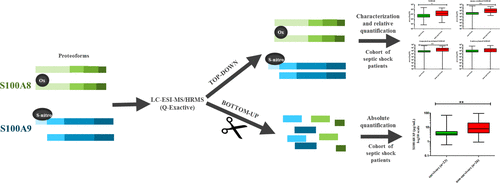当前位置:
X-MOL 学术
›
J. Proteome Res.
›
论文详情
Our official English website, www.x-mol.net, welcomes your feedback! (Note: you will need to create a separate account there.)
Top-Down and Bottom-Up Proteomics of Circulating S100A8/S100A9 in Plasma of Septic Shock Patients.
Journal of Proteome Research ( IF 4.4 ) Pub Date : 2020-01-22 , DOI: 10.1021/acs.jproteome.9b00690 Christelle Dubois 1 , Didier Payen 2, 3 , Stéphanie Simon 1 , Christophe Junot 1 , François Fenaille 1 , Nathalie Morel 1 , François Becher 1
Journal of Proteome Research ( IF 4.4 ) Pub Date : 2020-01-22 , DOI: 10.1021/acs.jproteome.9b00690 Christelle Dubois 1 , Didier Payen 2, 3 , Stéphanie Simon 1 , Christophe Junot 1 , François Fenaille 1 , Nathalie Morel 1 , François Becher 1
Affiliation

|
Well-characterized prognostic biomarkers and reliable quantitative methods are key in sepsis management. Among damage-associated molecular patterns, S100A8/S100A9 complexes are reported to be markers for injured cells and to improve the prediction of death in septic shock patients. In view of the structural diversity observed for the intracellular forms, insight into circulating complexes and proteoforms is required to establish prognostic biomarkers. Here, we developed top-down and bottom-up proteomics to characterize the association of S100A8 and S100A9 in complexes and major circulating proteoforms. An antibody-free method was developed for absolute quantification of S100A8/S100A9 in a cohort of 49 patients to evaluate the prognostic value on the first day after admission for septic shock. The predominant circulating forms identified by top-down proteomics were S100A8, mono-oxidized S100A8, truncated acetylated S100A9, and S-nitrosylated S100A9. S100A8, truncated acetylated S100A9, and mono-oxidized S100A8 discriminated between survivors and nonsurvivors, along with total S100A8/S100A9 measured by the antibody-free bottom-up method. Overall, new insights into circulating S100A8/S100A9 and confirmation of its prognostic value in septic shock are crucial in qualification of this biomarker. Also, the simple antibody-free assay would support the harmonization of S100A8/S100A9 measurements.
中文翻译:

败血症性休克患者血浆中循环S100A8 / S100A9的自上而下和自下而上的蛋白质组学。
表征良好的预后生物标志物和可靠的定量方法是败血症管理的关键。在损伤相关的分子模式中,据报道,S100A8 / S100A9复合物是受损细胞的标志物,并能改善败血性休克患者死亡的预测。鉴于观察到的细胞内形式的结构多样性,需要深入了解循环复合物和蛋白形式以建立预后生物标志物。在这里,我们开发了自上而下和自下而上的蛋白质组学,以表征复合体和主要循环蛋白形式中S100A8和S100A9的关联。开发了一种无抗体方法,可对49例患者的S100A8 / S100A9进行绝对定量,以评估感染性休克入院后第一天的预后价值。由上而下的蛋白质组学鉴定出的主要循环形式是S100A8,单氧化S100A8,截短的乙酰化S100A9和S-亚硝基化S100A9。在幸存者和非幸存者之间区分出S100A8,截短的乙酰化S100A9和单氧化S100A8,以及通过无抗体自下而上法测量的总S100A8 / S100A9。总体而言,对循环S100A8 / S100A9的新见解以及其在败血性休克中的预后价值的确认对于鉴定该生物标志物至关重要。同样,简单的无抗体检测将支持S100A8 / S100A9测量的统一。以及通过无抗体自下而上法测量的总S100A8 / S100A9。总体而言,对循环S100A8 / S100A9的新见解以及其在败血性休克中的预后价值的确认对于鉴定该生物标志物至关重要。同样,简单的无抗体检测将支持S100A8 / S100A9测量的统一。以及通过无抗体自下而上法测量的总S100A8 / S100A9。总体而言,对循环S100A8 / S100A9的新见解以及其在败血性休克中的预后价值的确认对于鉴定该生物标志物至关重要。同样,简单的无抗体检测将支持S100A8 / S100A9测量的统一。
更新日期:2020-01-23
中文翻译:

败血症性休克患者血浆中循环S100A8 / S100A9的自上而下和自下而上的蛋白质组学。
表征良好的预后生物标志物和可靠的定量方法是败血症管理的关键。在损伤相关的分子模式中,据报道,S100A8 / S100A9复合物是受损细胞的标志物,并能改善败血性休克患者死亡的预测。鉴于观察到的细胞内形式的结构多样性,需要深入了解循环复合物和蛋白形式以建立预后生物标志物。在这里,我们开发了自上而下和自下而上的蛋白质组学,以表征复合体和主要循环蛋白形式中S100A8和S100A9的关联。开发了一种无抗体方法,可对49例患者的S100A8 / S100A9进行绝对定量,以评估感染性休克入院后第一天的预后价值。由上而下的蛋白质组学鉴定出的主要循环形式是S100A8,单氧化S100A8,截短的乙酰化S100A9和S-亚硝基化S100A9。在幸存者和非幸存者之间区分出S100A8,截短的乙酰化S100A9和单氧化S100A8,以及通过无抗体自下而上法测量的总S100A8 / S100A9。总体而言,对循环S100A8 / S100A9的新见解以及其在败血性休克中的预后价值的确认对于鉴定该生物标志物至关重要。同样,简单的无抗体检测将支持S100A8 / S100A9测量的统一。以及通过无抗体自下而上法测量的总S100A8 / S100A9。总体而言,对循环S100A8 / S100A9的新见解以及其在败血性休克中的预后价值的确认对于鉴定该生物标志物至关重要。同样,简单的无抗体检测将支持S100A8 / S100A9测量的统一。以及通过无抗体自下而上法测量的总S100A8 / S100A9。总体而言,对循环S100A8 / S100A9的新见解以及其在败血性休克中的预后价值的确认对于鉴定该生物标志物至关重要。同样,简单的无抗体检测将支持S100A8 / S100A9测量的统一。


























 京公网安备 11010802027423号
京公网安备 11010802027423号